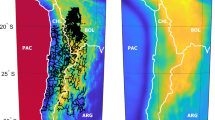Abstract
A realization of a height system covering the south of Norway has been performed, based on least-squares collocation applied to differences between geometric and gravimetric quasigeoid heights, inhomogeneous and isotropic covariance modelling, and without prior information on the error sources of the involved data types. As a result, the derived normal heights were biased by the systematic errors of the GPS-levelling network. The important covariance properties were determined at every location from spatially differenced observations, and made it straightforward to evaluate the uncertainties of the biased height reference. The distribution of predictions followed a Gaussian shape, but extreme realizations were overrepresented.






Similar content being viewed by others
References
Dahl OC, Forsberg R (1998) Geoid models around Sognefjord using depth data. J Geod 72:547–556
Darbeheshti N, Featherstone WE (2009) Non-stationary covariance function modelling in 2D least-squares collocation. J Geod 83:495–508
Darbeheshti N, Featherstone WE (2010a) Tuning a gravimetric quasigeoid to GPS-levelling by non-stationary least-squares collocation. J Geod 84:419–431
Darbeheshti N, Featherstone WE (2010b) A review of non-stationary spatial methods for geodetic least-squares collocation. J Spat Sci 55(2):185–204
Ekman M (1989) Impacts of geodynamic phenomena on systems for height and gravity. Bull Geod 63:281–296
Ekman M, Mäkinen J (1996) Recent postglacial rebound, gravity change and mantle flow in Fennoscandia. Geophys J Int 126:229–234
Geary RC (1954) The contiguity ratio and statistical mapping. Incorp Stat 5(3):115–146
Gelb A (ed) (1974) Applied optimal estimation. M.I.T Press, Cambridge
Huang C, Zhang H, Robeson S (2009) On the validity of covariance and variogram functions on the sphere. Technical Report 09–01, Indiana University. www.stat.indiana.edu/files/TR/TR-09-01
Klees R, Prutkin I (2010) The combination of GNSS-levelling data and gravimetric (quasi-) geoid heights in the presence of noise. J Geod 84:731–749
Kotsakis C, Sideris MG (1999) On the adjustment of combined GPS/levelling/geoid networks. J Geod 81:617–627
Moritz H (1980) Advanced physical geodesy. Wichmann, Karlsruhe
Nahavandchi H, Soltanpour A (2006) Improved determination of heights using a conversion surface by combining gravimetric quasi-geoid/geoid and GPS-levelling height differences. Stud Geophys Geod 50(80):165–180
Rasmussen CE, Williams CKI (2006) Gaussian processes for machine learning. M.I.T. Press, Cambridge
Soltanpour A, Nahavandchi H, Featherstone WE (2006) The use of second-generation wavelets to combine a gravimetric quasigeoid model with GPS-levelling data. J Geod 80:82–93
Tscherning CC, Forsberg R, Knudsen P (1992) Description of the GRAVSOFT package for geoid determination. In: Holota P, Vermeer M (eds) Proceedings of 1st continental workshop on the geoid in Europe. Research Institute of Geodesy, Topography and Cartography, Prague, pp 327–334
Vestøl O (2006) Determination of postglacial land uplift in Fennoscandia from leveling, tide-gauges and continuous GPS stations using least squares collocation. J Geod 80:248–258
Wessel P, Smith WHF (1998) New, improved version of the generic mapping tools released. EOS Trans AGU 79:579
Williams SDP, Bock Y, Fang P, Jamason P, Nikolaidis RM, Miller M, Johnson DJ (2004) Error analysis of continuous GPS position time series. J Geophys Res 109:B03142. doi:10.1029/2003JB002741
Williams T, Kelley C (2012) Gnuplot 4.6: an interactive plotting program. http://gnuplot.info
Acknowledgments
Author information
Authors and Affiliations
Corresponding author
Rights and permissions
About this article
Cite this article
Mysen, E. On the computation of reliable formal uncertainties in the densification of GPS-levelling networks by least-squares collocation. J Geod 88, 917–926 (2014). https://doi.org/10.1007/s00190-014-0732-x
Received:
Accepted:
Published:
Issue Date:
DOI: https://doi.org/10.1007/s00190-014-0732-x




